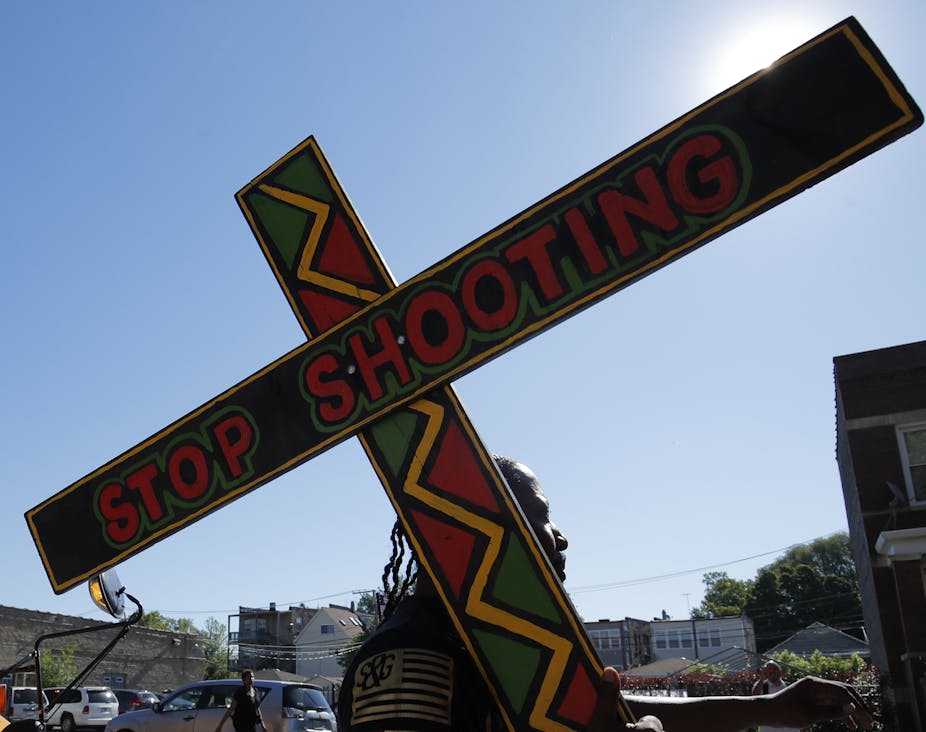The July 4 weekend was one of the deadliest in recent U.S. history, with 160 people, including several small children, killed by gun violence in Chicago, New York, Atlanta and beyond.
And the body count keeps rising. Columbus, Ohio, where I teach and study violence prevention, had 13 homicides in the first 26 days of July, according to police data – 46% higher than July 2019. Many shooting victims are from the same Black neighborhoods in cities that have borne the burden of American gun violence for decades.
Urban gun violence is an entrenched but not intractable problem, evidence shows. Since the 1990s community anti-violence initiatives – many of them run out of churches – have reduced crime locally, at least temporarily, by “interrupting” potential violence before it happens.

Preventable violence
One such program is Cure Violence, previously called Chicago CeaseFire. Founded in 1999 with Illinois state funding, CeaseFire employed community members with street credibility – that is, status in their community – to identify those at highest risk of being shot or being a shooter, then intervene in feuds that might otherwise end with fatal gunfire.
Working with churches, schools and community groups like the Boys and Girls Club, CeaseFire also helped gang members and at-risk youth move beyond street life by finishing their studies, finding a job or enrolling in drug and alcohol treatment.
A National Institute of Justice evaluation found that between 1991 and 2006, CeaseFire helped shootings decline 16% to 28% in four of the seven Chicago neighborhoods studied.
Variations of the CeaseFire program run by law enforcement, public health experts and hospitals have also substantially reduced gun violence in Cincinnati, New York, Boston and beyond. However, many of these successful initiatives, including Chicago CeaseFire, were ultimately scaled back or terminated due to a lack of sustained funding.

Restorative justice
That’s what happened to CeaseFire Columbus, an Ohio program modeled after Chicago’s program but with a religious orientation.
CeaseFire Columbus was run by Ministries for Movement, an anti-violence community organization founded in the deadly summer of 2009. After 20-year-old Dominique Searcy became Columbus’ 52nd murder victim that year, Dominique’s uncle, Cecil Ahad, teamed up with local youth and the former gang leader Dartangnan Hill for a “homicidal pain” march through their community of South Side Columbus.

A local pastor, Frederick LaMarr, offered his Family Missionary Baptist Church to host the group’s anti-violence work, giving rise to Ministries for Movement. In 2010, having studied Columbus’ crime data, I invited the group to implement a local CeaseFire program.
CeaseFire Columbus adopted many of Chicago’s violence interruption tactics, but the guiding philosophy of Pastor LaMarr and Brother Ahad was to meet everyone with compassion and openness, whether they were a grieving mother or a gang member.
To convince high-risk young people to stop killing each other, they used positive motivation – not threats of jail time, as some CeaseFire programs do. Evidence shows young people trapped in a cycle of violence are often willing to drop their guns for the chance of a better life: a high school degree, say, or a job offer in a field of interest.
LaMarr and Ahad also encouraged perpetrators of violence to take responsibility for their actions. Sometimes, that meant turning themselves in to authorities. Other times, it meant making amends through community service.
Ministries for Movement has helped several hundred young Columbus residents escape gangs. My evaluation for The Ohio State University found that between 2011 to 2014, CeaseFire Columbus helped to reduce shootings by 76% in our 40-block target area. For one 27-month period, no one was murdered.
The first homicide after those two years of peace was heartbreaking. The victim, 24-year-old Rondell Brinkley, had been turning his life around with the help of Ministries for Movement. Days before his murder, Brinkley had inspired attendees at a community event with his personal story of change.

Gardening for change
Violence interruption works, but it takes intensive and sustained effort. That can be difficult with a volunteer staff.
CeaseFire Columbus achieved its best results after getting US$125,000 in grants to expand its street outreach, community mobilizing, public health messaging and conflict mediation. Funding came from The Ohio State University, the Ohio attorney general’s office and the U.S. attorney for the Southern District of Ohio.
Ministries for Movement is still active in South Side Columbus: It leads a healing march on the first Sunday of each month, among other activities. But CeaseFire became a casualty of lost funding and city politics. With gun violence quieter in our area but spiking in other parts of Columbus, Ministries for Movement is now sharing its approach with community members and faith leaders in those areas.
[You’re too busy to read everything. We get it. That’s why we’ve got a weekly newsletter. Sign up for good Sunday reading. ]
It is also trying something new to stop the violence: gardening.

In 2015, with Department of Agriculture funding, I worked with Ohio State to launch the Urban Gardening Entrepreneurs Motivating Sustainability program and planted a garden at Pastor LaMarr’s church, replacing the overgrown rusty fence line of an abandoned neighboring house.
Urban Gardening Entrepreneurs Motivating Sustainability helps young people build skills, strengthen social connections and improve health in their communities by growing and selling fresh food. Many of the program’s 300 participants have witnessed gun violence and deaths. Many say they find gardening therapeutic.
Surveys I’ve conducted find that Urban Gardening Entrepreneurs Motivating Sustainability improves participants’ eating habits, problem-solving and leadership skills, persistence and workforce readiness.
“Personally, it has taught me a lot of things: How to eat healthier, how to grow produce,” said Nasir Groce, who is now 13 years old, back in 2017. “It’s taught me that I can do anything I put my mind to.”

